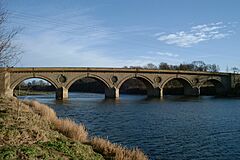Coldstream Bridge facts for kids
Quick facts for kids Coldstream Bridge |
|
|---|---|

The bridge over the River Tweed at Coldstream
|
|
| Coordinates | 55°39′14″N 2°14′31″W / 55.654°N 2.242°W |
| Carries | Road traffic |
| Crosses | River Tweed |
| Locale | Northumberland, England/ Scottish Borders, Scotland |
| Heritage status | Category A/Grade II* listed |
| Characteristics | |
| Material | Sandstone blocks |
| History | |
| Architect | John Smeaton |
| Engineering design by | Robert Reid |
| Construction begin | 1763 |
| Construction end | 1766 |
| Construction cost | £6,000 |
| Statistics | |
| Daily traffic | Single carriageway |
| Toll | No |
The Coldstream Bridge is a historic bridge that connects Coldstream, Scottish Borders in Scotland with Cornhill-on-Tweed, Northumberland in England. It crosses the River Tweed. This bridge was built in the 1700s and is a very important listed building. It carries the A697 road between the two countries.
The Coldstream Bridge is one of three bridges that cross the River Tweed right on the border between England and Scotland. It is the oldest of these three bridges. The other two are the Union Chain Bridge and the Ladykirk and Norham Bridge.
Contents
History of the Bridge
The Coldstream Bridge was designed by a famous engineer named John Smeaton. He also designed the third Eddystone Lighthouse. The building of the bridge started in July 1763 and finished on October 28, 1766. That's when cars and people could start using it.
The bridge cost about £6,000 to build. This was a lot of money back then! The government helped pay for some of it. Local people and banks in Edinburgh loaned the rest. They planned to get their money back by charging a toll to cross the bridge.
There was a small problem during construction. The engineer in charge, Robert Reid, used some money to build a house for himself. But John Smeaton explained that the house would actually help support the bridge. He also thought Robert Reid was not paid enough for his hard work.
Over the years, the bridge has been updated. In 1784, a special wall called a weir was built downstream. This helped stop the river from washing away the bridge's base. In 1922, the foundations were made stronger with concrete. More changes happened in 1928. Then, in 1960–1961, big repairs were done to make the bridge even stronger and wider.
A special plaque on the bridge remembers when the famous Scottish poet Robert Burns visited Coldstream in 1787.
The Wedding House
On the Scottish side of the bridge, there's an old toll house. This house became famous for "runaway marriages." Just like at Gretna Green, young couples would come here to get married quickly. This is why it was called the 'Wedding House' or 'Marriage House'. People stopped paying tolls to cross the bridge in 1826.
A Protected Building
The Coldstream Bridge is a very important historical structure. Because of this, it is a "listed building." This means it's protected by law because of its special history and design.
The part of the bridge in England (Northumberland) was given a Grade II* listing in 1952. Experts said it was a "well-proportioned, and carefully-detailed" bridge from the 1700s.
The part of the bridge in Scotland (Scottish Borders) was given a Category A listing in 1971. It was called a "very fine example" of an 18th-century bridge. They noted it was designed by John Smeaton and built with beautiful sandstone.
How the Bridge is Built
The Coldstream Bridge is made from strong sandstone blocks. These blocks are carefully shaped and fitted together. Above each support pillar, there is a round opening called an oculus. These openings are filled with a type of stone called whinstone.
The bridge has five main arches. These arches get bigger and taller towards the middle of the bridge. Each arch has special decorative stones called keystones. At each end of the bridge, there's a smaller arch. These are called "flood arches" and help water flow through during floods.
Right downstream from the bridge, there is a weir called the Cauld. This weir was built in 1785. It helps protect the bridge from being worn away by the river's strong currents.
Gallery
See also






